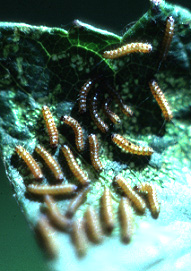
Grapeleaf skeletonizer, Harrisina americana (Guerin)
This is taken primarily from an
extension bulletin by D. G. Pfeiffer & P. B. Schultz, entitled
"Major Insect and
Mite Pests of Grape in Virginia" (Va. Coop. Ext. Serv. 444-567 (1986))
This species occurs widely in the eastern U.S.;
a related species,
the western grapeleaf skeletonizer (H. brillians Barnes &
McDunnough),
replaces it in the west. Pupae pass the winter in cocoons in debris on
the ground. In late spring, adults emerge and eggs are deposited in
yellow clusters on lower leaf surfaces. After hatching, larvae feed in
upper leaf surfaces, often feeding side-by-side in a row. Young larvae
skeletonize leaves; older larvae feed on entire leaves. Larvae are
yellow
with four black tubercles on each body segment. Adults are small,
black,
narrow-winged moths. There are two generations annually.
See page on grapeleaf
skeletonizer
on
Virginia creeper, and California page on western
grapeleaf skeletonizer
Back to Virginia
Vineyard
page
Back to Virginia Fruit
Page